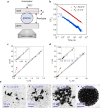Predicting frictional aging from bulk relaxation measurements
- PMID: 37330517
- PMCID: PMC10276840
- DOI: 10.1038/s41467-023-39350-3
Predicting frictional aging from bulk relaxation measurements
Abstract
The coefficient of static friction between solids normally increases with the time they have remained in static contact before the measurement. This phenomenon, known as frictional aging, is at the origin of the difference between static and dynamic friction coefficients but has remained difficult to understand. It is usually attributed to a slow expansion of the area of atomic contact as the interface changes under pressure. This is however challenging to quantify as surfaces have roughness at all length scales. In addition, friction is not always proportional to the contact area. Here we show that the normalized stress relaxation of the surface asperities during frictional contact with a hard substrate is the same as that of the bulk material, regardless of the asperities' size or degree of compression. This result enables us to predict the frictional aging of rough interfaces based on the bulk material properties of two typical polymers: polypropylene and polytetrafluoroethylene.
© 2023. The Author(s).
Conflict of interest statement
The authors declare no competing interests.
Figures




Similar articles
-
Frictional weakening of slip interfaces.Sci Adv. 2019 Apr 5;5(4):eaav7603. doi: 10.1126/sciadv.aav7603. eCollection 2019 Apr. Sci Adv. 2019. PMID: 30972367 Free PMC article.
-
The influence of nanoscale roughness and substrate chemistry on the frictional properties of single and few layer graphene.Nanoscale. 2015 Jun 14;7(22):10021-9. doi: 10.1039/c5nr01478f. Epub 2015 Apr 22. Nanoscale. 2015. PMID: 25899217
-
The evolving quality of frictional contact with graphene.Nature. 2016 Nov 24;539(7630):541-545. doi: 10.1038/nature20135. Nature. 2016. PMID: 27882973
-
Friction Behavior of Rough Surfaces on the Basis of Contact Mechanics: A Review and Prospects.Micromachines (Basel). 2022 Nov 4;13(11):1907. doi: 10.3390/mi13111907. Micromachines (Basel). 2022. PMID: 36363928 Free PMC article. Review.
-
Friction of sea ice.Philos Trans A Math Phys Eng Sci. 2018 Sep 28;376(2129):20170336. doi: 10.1098/rsta.2017.0336. Philos Trans A Math Phys Eng Sci. 2018. PMID: 30126910 Free PMC article. Review.
References
-
- Persson, B. N. J. Sliding Friction Physical Principles and Applications (Springer, 2000).
-
- Baumberger T, Caroli C. Solid friction from stick–slip down to pinning and aging. Adv. Phys. 2006;55:279–348. doi: 10.1080/00018730600732186. - DOI
-
- Dieterich JH, Kilgore BD. Direct observation of frictional contacts: new insights for state-dependent properties. Pure Appl. Geophys. 1994;143:283–302. doi: 10.1007/BF00874332. - DOI
Grants and funding
LinkOut - more resources
Full Text Sources

